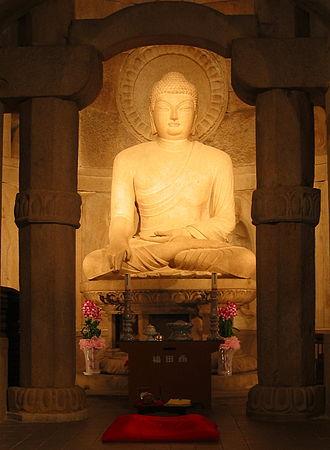
Again evoking historical developments, following so Buddha’s heir and lineages, we move from China to Korea, Seung Sahn Soen Sa Nim’s homeland. The Dharma Wheel goes on and finds further adepts, further realities in constant expansion. In a society marked by earlier Shamanic beliefs, a sprouting number of Chan influenced teachers appear on the scene. Here begins the 2000 years old history of Korean Buddhism, an ongoing process of building and renewing, often of destruction, told through its highlights and its depressions, through the life of its eminent Masters and Patriarchs, its society, arriving to our days with Korean schools spreading all over the world. So what is the history of Korean Seon, its philosophy, structure and form? In which context did Jacob Perl find himself in 1972, as he met Seung Sahn Soen Sa Nim in Providence, USA, becoming his first American student?
Following are some brief introductions, which come together with a couple of links to videos related to Korean Buddhism. Moreover, a super classical: Why has Bodhi Dharma left for the East?, a gem of South Korean Cinema from 1989 by Bae Yong-kyun fished from Youtube; and other links to deepen our own research, starting from portals containing Buddhist Korean Writings from many centuries – listed at the end. The images feature mostly Seon Masters from different eras, at the very end some politicians of the last century from what eventually became the two Koreas. Just to give an impression.
Korean Buddhism is distinguished from other forms of Buddhism by its attempt to resolve what it sees as inconsistencies in Mahayana Buddhism. Early Korean monks believed that the traditions they received from foreign countries were internally inconsistent. To address this, they developed a new holistic approach to Buddhism. This approach is characteristic of virtually all major Korean thinkers, and has resulted in a distinct variation of Buddhism, which is called Tongbulgyo (“interpenetrated Buddhism”), a form that sought to harmonize all disputes (a principle called hwajaeng 和諍) by Korean scholars. Korean Buddhist thinkers refined their predecessors’ ideas into a distinct form.
As it now stands, Korean Buddhism consists mostly of the Seon lineage, primarily represented by the Jogye and Taego Orders. Seon has a strong relationship with other Mahayana traditions that bear the imprint of Chinese Chán teachings as well as the closely related Zen. Other sects, such as the modern revival of the Cheontae lineage, the Jingak Order (simplified Chinese: 大韩佛敎眞觉宗; Korean: 대한불교진각종, a modern esoteric sect), and the newly formed Won, have also attracted sizable followings.
Korean Buddhism has also contributed much to East Asian Buddhism, especially to early Chinese, Japanese, and Tibetan schools of Buddhist thought.
Historical overview of the development of Korean Buddhism
Korean Shamanism held three spirits in especially high regard: Sanshin (the Mountain Spirit), Toksong (the Recluse) and Chilsong (the Spirit of the Seven Stars, the Big Dipper). Korean Buddhism accepted and absorbed these three spirits and, even today, special shrines are set aside for them in many temples. The Mountain Spirit receives particular recognition in an attempt to appease the local mountain spirits, on whose land the temple stands. This blend of Buddhism and Shamanism became known as Korean Buddhism, although the fundamental teachings of the Buddha remained.
Though it initially enjoyed wide acceptance, even being supported as the state ideology during the Goryeo period, Buddhism in Korea suffered extreme repression during the Joseon Dynasty, which lasted for over five hundred years. During this period, Neo-Confucian ideology overcame the prior dominance of Buddhism.
Only after Buddhist monks helped repel a Japanese invasion at the end of the 16th century (see Imjin wars) did the persecution of Buddhism and Buddhist practitioners stop. Buddhism in Korea remained subdued until the end of the Joseon period, when its position was strengthened somewhat by the colonial period, which lasted from 1910 to 1945. After World War II, the Seon school of Korean Buddhism once again gained acceptance.
A 2005 government survey indicated that about a quarter of South Koreans identified as Buddhist. However, the actual number of Buddhists in South Korea is ambiguous as there is no exact or exclusive criterion by which Buddhists can be identified, unlike the Christian population. With Buddhism’s incorporation into traditional Korean culture, it is now considered a philosophy and cultural background rather than a formal religion. As a result, many people outside of the practicing population are deeply influenced by these traditions. Thus, when counting secular believers or those influenced by the faith while not following other religions, the number of Buddhists in South Korea is considered to be much larger. Similarly, in officially atheist North Korea, while Buddhists officially account for 4.5% of the population, a much larger number (over 70%) of the population are influenced by Buddhist philosophies and customs.
Buddhism in the Three Kingdoms
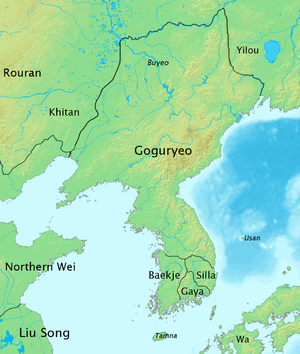
When Buddhism was introduced to Korea in the 4th century CE, the Korean peninsula was politically subdivided into three kingdoms: Goguryeo in the north (which included territory currently in Russia and China), Baekje in the southwest, and Silla in the southeast. There is concrete evidence of an earlier introduction of Buddhism than traditionally believed. A mid-4th century tomb, unearthed near P’yǒngyang, is found to incorporate Buddhist motifs in its ceiling decoration.
Some Korean Buddhist monks traveled to China or India in order to study Buddhism in the late Three Kingdoms Period, especially in the 6th century. In 526, The monk Gyeomik (謙益) from Baekje travelled via the southern sea route to India to learn Sanskrit and study Vinaya. The monk Paya (波若; 562–613?) from Goguryeo is said to have studied under the Tiantai master Zhiyi, and other Korean monks of the period brought back numerous scriptures from abroad and conducted missionary activity throughout Korea.
Several schools of thought developed in Korea during these early times:
- the Samnon (三論宗, or Sanlun in Chinese) school focused on the Indian Mādhyamika (Middle Path) doctrine,
- the Gyeyul (戒律宗, or Vinaya in Sanskrit) school was mainly concerned with the study and implementation of moral discipline (śīla), and
- the Yeolban (涅槃宗, or Nirvāna in Sanskrit) school, which was based in the themes of the Mahāparinirvāna-sūtra
Toward the end of the Three Kingdoms Period, the Wonyung (圓融宗, or Yuanrong in Chinese) school was formed. It would lead the actualization of the metaphysics of interpenetration as found in the Avatamsaka Sutra and soon was considered the premier school, especially among the educated aristocracy. This school was later known as Hwaeom (華嚴宗, or Huayan in Chinese) and was the longest lasting of these “imported” schools. It had strong ties with the Beopseong (法性宗), the indigenous Korean school of thought.
The date of the first mission from Korea to Japan is unclear, but it is reported that a second detachment of scholars was sent to Japan upon invitation by the Japanese rulers in 577. The strong Korean influence on the development of Buddhism in Japan continued through the Unified Silla period; only in the 8th century did independent study by Japanese monks begin in significant numbers.
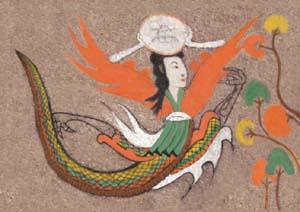
Goguryeo
In 372, the monk Sundo (順道, or Shundao in Chinese) was sent by Fu Jiān (苻堅) of Former Qin to the court of the King Sosurim of Goguryeo. He brought texts and statues (possibly of Maitreya Bodhisattva who was popular in Central Asian Buddhism), and the Goguryeo royalty and their subjects quickly accepted his teachings. Buddhism in China was in a rudimentary form, consisting of the law of cause and effect and the search for happiness. This had much in common with the predominant Shamanism, which likely led to the quick assimilation of Buddhism by the people of Goguryeo.
Early Buddhism in Silla developed under the influence of Goguryeo. Some monks from Goguryeo came to Silla and preached among the people, making a few converts. In 551, Hyeryang (惠亮), a Goguryeo monk was appointed the first National Patriarch (kukt’ong) of Silla. He first presided over the One Hundred Seat Dharma Assembly (paekchwa hanghoe) and the Dharma of Eight Prohibitions (p’algwan pop).
Baekje
In 384, the Indian monk Marananta arrived in Baekje and the royal family received the similar strain of Buddhism he brought. King Asin proclaimed, “people should believe in Buddhism and seek happiness.” In 526, the Baekje monk Gyeomik (겸익, 謙益) went directly to Central India and came back with a collection of Vinaya texts, accompanied by the Indian monk Paedalta. After returning to Baekje he translated the Buddhist scriptures in Sanskrit into seventy-two volumes. The Vinaya School in Baekje was established by Gyeomik, about a century earlier than that of in China. As a result of the work, he is regarded as the father of Vinaya studies in Korea.
Silla
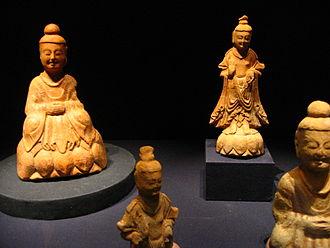
Buddhism did not enter the kingdom of Silla until the 5th century. The common people were first attracted to Buddhism here, but there was resistance among the aristocrats. In 527, however, a prominent court official named Ichadon presented himself to King Pophung and announced he had become Buddhist. The king had him beheaded, but when the executioner cut off his head, it is said that milk poured out instead of blood. Paintings of this are in the temple at Haein-sa and a stone monument honoring his martyrdom is in the National Museum of Kyongju.
During the reign of the next king, King Chinhung, the growth of Buddhism was encouraged — eventually being recognized as the national religion of Silla. Additionally, selected young men were physically and spiritually trained at Hwarangdo according to Buddhist principles to be able to defend the kingdom. King Chinhung later became a monk himself.
The monk Jajang (慈藏) is credited with having been a major force in the adoption of Buddhism as a national religion. Jajang is also known for his participation in the founding of the Korean sangha, a type of monastic community.

Another great scholar to emerge from the Silla Period was Won-hyo. He renounced his religious life to better serve the people and even married a princess for a short time and had a son. He wrote many treatises and his philosophy centered on the unity and interrelatedness of all things. He set off to China to study Buddhism with a close friend, Ui-sang, but only made it part of the way there. The legend is that Won-hyo awoke one night very thirsty, found a container with cool water, drank, and returned to sleep. The next morning he saw the container from which he had drunk was a human skull and he realized all enlightenment depended on the mind. He saw no reason to continue to China, so he returned home. His companion, Ui-sang, continued to China and after studying ten years, offered a poem to his master in the shape of a seal that geometrically represents infinity. The poem contained the essence of the Avatamsaka Sutra.
Buddhism was so successful during this period that many kings converted and cities/places were even renamed after famous places during the time of Buddha.
Buddhism in the North South States Period
In 668, the kingdom of Silla succeeded in unifying the whole Korean peninsula, giving rise to a period of political stability that lasted for about one hundred years. This led to a high point in the scholarly studies of Buddhism in Korea. In general, the most popular areas of study were Wonyung, Yusik (Ch. 唯識; Weishi; “consciousness-only”; the East Asian form of Yogācāra), Jeongto (Pure Land), and the indigenous Korean Beopseong (“dharma-nature school”). The monk Wonhyo taught the “Pure Land”-practice of yeombul, which would become very popular amongst both scholars and laypeople, and has had a lasting influence on Buddhist thought in Korea. His work, which attempts a synthesis of the seemingly divergent strands of Indian and Chinese Buddhist doctrine, makes use of the essence-function (體用, or che-yong) framework, which was popular in native East Asian philosophical schools. His work was instrumental in the development of the dominant school of Korean Buddhist thought, known variously as Beopseong, Haedong (海東, “Korean”) and later as Jungdo (中道, “Middle way”)Uisang
Wonhyo’s friend Uisang (義湘) went to Chang’an, where he studied under Huayan patriarchs Zhiyan (智儼; 600–668) and Fazang (法藏; 643–712). When he returned after twenty years, his work contributed to Hwaeom and became the predominant doctrinal influence on Korean Buddhism, together with Wonhyo’stong bulgyo thought. Hwaeom principles were deeply assimilated into the Korean meditational school, the Seon school, where they made a profound effect on its basic attitudes.
Influences from Silla Buddhism in general, and from these two philosophers in particular, even crept “backwards” into Chinese Buddhism. Wonhyo’s commentaries were very important in shaping the thought of the preeminent Chinese Buddhist philosopher Fazang, and Woncheuk’s commentary on the Saṃdhinirmocana-sūtra had a strong influence inTibetan Buddhism.
The intellectual developments of Silla Buddhism brought with them significant cultural achievements in many areas, including painting, literature, sculpture, and architecture. During this period, many large and beautiful temples were built. Two crowning achievements were the temple Bulguksa and the cave-retreat of Seokguram (石窟庵). Bulguksa was famous for its jeweled pagodas, while Seokguram was known for the beauty of its stone sculpture.
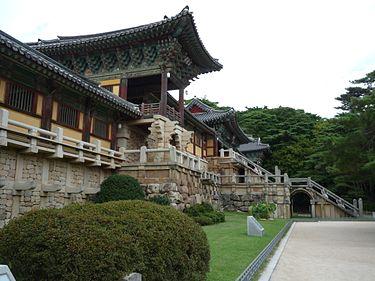
Balhae
Buddhism also flourished in the northern Korean Kingdom of Balhae, established after the fall of Goguryeo, as the state religion. The remains of ten Buddhist temples have been found in the remains of the capital of Balhae, Sanggyŏng, together with such Buddhist artifacts as Buddha statuettes and stone lanterns suggest that Buddhism played a predominant role in the life of the Balhae people. The Balhae tomb Majeokdal in SinpoHamgyeongnam-do, are associated with pagodas and temples: This also indicates that Buddhism had a strong influence over the funerary rituals in Balhae.
After the fall of Balhae, sixty monks from Balhae including the monk Jaeung (載雄) fled together to the newly founded kingdom of Goryeo (918-1392).
Seon
"Why has Bodhi Dharma left for the East?", a classical of South Korean Cinema from 1989 by Bae Yong-kyun.
A new epoch in Korean Buddhism began during the latter Silla with the birth of schools of Seon in Korea. In China, the movement toward a meditation-based view of practice, which came to be known as Chan, had begun during the sixth and seventh centuries, and it was not long before the influence of the new meditational school reached Korea, where it was known as Seon. Meaning “meditation,” the term is more widely known in the West in its Japanese variant Zen. Tension developed between the new meditational schools and the previously existing academically oriented schools, which were described by the term gyo, meaning “learning” or “study.”
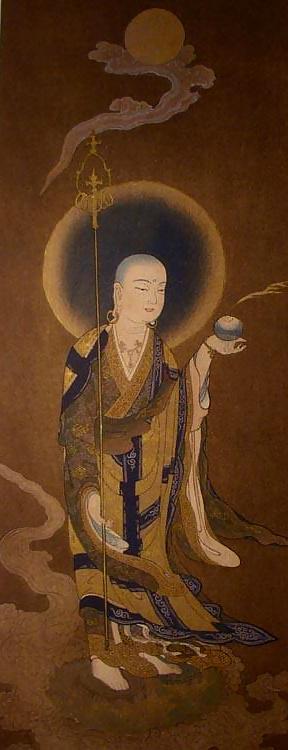
Kim Gyo-gak (金喬覺; 630–729), a prince who became a monastic, came to the region of Anhui to Mount Jiuhua in China. Many Chinese Buddhists believe he was indeed the transformation body of Kṣitigarbha. Two uncles sent by his mother and wife to call him back also became monastics there. His well-preserved, dehydrated body is seen at the monastery he built on Mount Jiuhua today. The two uncles, unable to resist wine and meat as they were official before becoming monastics, practiced in another place on the mount. People built the palace of the two saints (二聖殿) in their practice place to memorialize them. Many Buddhists visit there.
Beomnang (法朗; fl. 632–646), said to be a student of the Chinese master Daoxin (道信; 580–651), is generally credited with the initial transmission of Seon into Korea. Seon was popularized by Sinhaeng (神行; 704–779) in the latter part of the eighth century and by Doui (道義; died 825) at the beginning of the ninth century. From then on, many Koreans studied Chan in China, and upon their return established their own schools at various mountain monasteries with their leading disciples. Initially, the number of these schools was fixed at nine, and Korean Seon was termed the “nine mountains” (九山 or gusan) school at the time. Eight of these were of the lineage of Mazu Daoyi (馬祖道一; 709–788), as they were established through connection with either him or one of his eminent disciples. The one exception was the Sumi-san school founded by Ieom (利嚴; 869–936), which had developed from the Caodong (曹洞) lineage.
Buddhism as state religion in the Goryeo period (918–1392)
Sam-Taegeukand Gankyil.
As Buddhism in medieval Korea evolved, it served to legitimize the state. Initially, the new Seon schools were regarded by the established doctrinal schools as radical and dangerous upstarts. Thus, the early founders of the various “nine mountain” monasteries met with considerable resistance, repressed by the long influence in court of the Gyo schools. The struggles which ensued continued for most of the Goryeo period, but gradually the Seon argument for the possession of the true transmission of enlightenment would gain the upper hand. The position that was generally adopted in the later Seon schools, due in large part to the efforts of Jinul, did not claim clear superiority of Seon meditational methods, but rather declared the intrinsic unity and similarities of the Seon and Gyo viewpoints. Although all these schools are mentioned in historical records, toward the end of the dynasty, Seon became dominant in its effect on the government and society, and the production of noteworthy scholars and adepts. During the Goryeo period, Seon thoroughly became a “religion of the state,” receiving extensive support and privileges through connections with the ruling family and powerful members of the court.
Although most of the scholastic schools waned in activity and influence during this period of the growth of Seon, the Hwaeom school continued to be a lively source of scholarship well into the Goryeo, much of it continuing the legacy of Uisang and Wonhyo. In particular the work of Gyunyeo (均如; 923–973) prepared for the reconciliation of Hwaeom and Seon, with Hwaeom’s accommodating attitude toward the latter. Gyunyeo’s works are an important source for modern scholarship in identifying the distinctive nature of Korean Hwaeom.
Another important advocate of Seon/Gyo unity was Uicheon. Like most other early Goryeo monks, he began his studies in Buddhism with Hwaeom. He later traveled to China, and upon his return, actively promulgated the Cheontae (天台宗, or Tiantai in Chinese) teaching, which became recognized as another Seon school. This period thus came to be described as “five doctrinal and two meditational schools” (ogyo yangjong). Uicheon himself, however, alienated too many Seon adherents, and he died at a relatively young age without seeing a Seon-Gyo unity accomplished.
The most important figure of Seon in the Goryeo was Jinul (知訥; 1158–1210). In his time, the sangha was in a crisis of external appearance and internal issues of doctrine. Buddhism had gradually become infected by secular tendencies and involvements, such as fortune-telling and the offering of prayers and rituals for success in secular endeavors. This kind of corruption resulted in the profusion of increasingly larger numbers of monks and nuns with questionable motivations. Therefore, the correction, revival, and improvement of the quality of Buddhism were prominent issues for Buddhist leaders of the period.
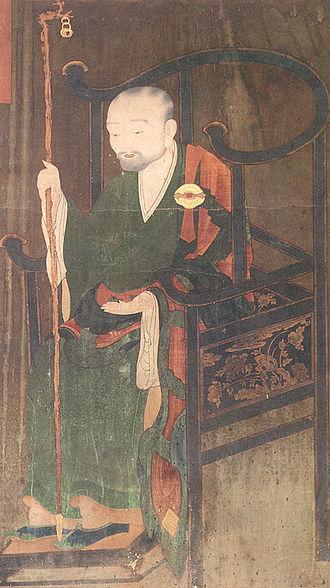
Jinul sought to establish a new movement within Korean Seon, which he called the “samādhi and prajñā society”, whose goal was to establish a new community of disciplined, pure-minded practitioners deep in the mountains. He eventually accomplished this mission with the founding of the Songgwangsa monastery at Mt. Jogye (曹溪山). Jinul’s works are characterized by a thorough analysis and reformulation of the methodologies of Seon study and practice. One major issue that had long fermented in Chinese Chan, and which received special focus from Jinul, was the relationship between “gradual” and “sudden” methods in practice and enlightenment. Drawing upon various Chinese treatments of this topic, most importantly those by Zongmi (780–841) and Dahui (大慧; 1089–1163), Jinul created a “sudden enlightenment followed by gradual practice” dictum, which he outlined in a few relatively concise and accessible texts. From Dahui, Jinul also incorporated the gwanhwa (觀話) method into his practice. This form of meditation is the main method taught in Korean Seon today. Jinul’s philosophical resolution of the Seon-Gyo conflict brought a deep and lasting effect on Korean Buddhism.
The general trend of Buddhism in the latter half of the Goryeo was a decline due to corruption, and the rise of strong anti-Buddhist political and philosophical sentiment. However, this period of relative decadence would nevertheless produce some of Korea’s most renowned Seon masters. Three important monks of this period who figured prominently in charting the future course of Korean Seon were contemporaries and friends: Gyeonghan Baeg’un (景閑白雲; 1298–1374), Taego Bou (太古普愚; 1301–1382) and Naong Hyegeun (懶翁慧勤; 1320–1376). All three went to Yuan China to learn the Linji (臨濟 or Imje in Korean) gwanhwa teaching that had been popularized by Jinul. All three returned, and established the sharp, confrontational methods of the Imje school in their own teaching. Each of the three was also said to have had hundreds of disciples, such that this new infusion into Korean Seon brought about considerable effect. Despite the Imje influence, which was generally considered to be anti-scholarly in nature, Gyeonghan and Naong, under the influence of Jinul and the traditional tong bulgyo tendency, showed an unusual interest in scriptural study, as well as a strong understanding of Confucianism and Taoism, due to the increasing influence of Chinese philosophy as the foundation of official education. From this time, a marked tendency for Korean Buddhist monks to be “three teachings” exponents appeared.Tripitaka Koreana
A significant historical event of the Goryeo period is the production of the first woodblock edition of the Tripitaka, called the Tripitaka Koreana. Two editions were made, the first one completed from 1210 to 1231, and the second one from 1214 to 1259. The first edition was destroyed in a fire, during an attack by Mongol invaders in 1232, but the second edition is still in existence at Haeinsa in Gyeongsang province. This edition of the Tripitaka was of high quality, and served as the standard version of the Tripitaka in East Asia for almost 700 years.
Suppression under the Joseon Dynasty (1392–1910)
In 1388, an influential general named Yi Seonggye (1335–1408) carried out a coup d’état and established himself as the first ruler of the Joseon dynasty in 1392 with the support of this Neo-Confucian movement – he was posthumously renamed Emperor Taejo of Joseon in 1899. Joseon Buddhism, which had started off under the so-called “five doctrinal and two meditational” schools system of the Goryeo, was first condensed to two schools: Seon and Gyo. Eventually, these were further reduced to the single school of Seon.
Despite this strong suppression from the government, and vehement ideological opposition from Korean Neo-Confucianism, Seon Buddhism continued to thrive intellectually. An outstanding thinker was Gihwa (己和; (Hamheo Deuktong 涵虚得通) 1376–1433), who had first studied at a Confucian academy, but then changed his focus to Buddhism, where he was initiated to the gwanhwa tradition by Muhak Jacho (無學自超; 1327–1405). He wrote many scholarly commentaries, as well as essays and a large body of poetry. Being well-versed in Confucian and Taoist philosophies, Giwha also wrote an important treatise in defense of Buddhism, from the standpoint of the intrinsic unity of the three teachings, entitled the Hyeonjeong non. In the tradition of earlier philosophers, he applied che-yong (“essence-function”) and Hwaeom (sa-sa mu-ae, “mutual interpenetration of phenomena”).
Common in the works of Joseon scholar-monks are writings on Hwaeom-related texts, as well as the Awakening of Faith in the Mahayana, Sutra of Perfect Enlightenment, Śūraṅgama Sūtra, Diamond Sutra and the Heart Sutra. The Jogye order instituted a set curriculum of scriptural study, including the above-mentioned works, along with other shorter selections from eminent Korean monks, such as Jinul.
During the Joseon period, the number of Buddhist monasteries dropped from several hundred to a mere thirty-six. Limits were placed on the number of clergy, land area, and ages for entering the sangha. When the final restrictions were in place, monks and nuns were prohibited from entering the cities. Buddhist funerals, and even begging, were outlawed. However, some rulers occasionally appeared who looked favorably upon Buddhism and did away with some of the more suppressive regulations. The most noteworthy of these was the Queen Munjeong, who, as a devout Buddhist, took control of the government in the stead of her young son Myeongjong (r. 1545–67), and immediately repealed many anti-Buddhist measures. The queen had deep respect for the brilliant monk Bou (보우, 普雨; 1515–1565), and installed him as the head of the Seon school.

One of the most important reasons for the restoration of Buddhism to a position of minimal acceptance was the role of Buddhist monks in repelling the Japanese invasions of Korea, which occurred between 1592 and 1598. At that time, the government was weak from internal squabbles, and was not initially able to muster strong resistance to the incursion. The plight of the country encouraged some leaders of the sangha to organize monks into guerrilla units, which enjoyed some instrumental successes. The “righteous monk” (義士; uisa) movement spread during this eight-year war, finally including several thousand monks, led by the aging Hyujeong (서산대사, 西山休靜; 1520–1604), a first-rate Seon master and the author of a number of important religious texts. The presence of the monks’ army was a critical factor in the eventual expulsion of the Japanese invaders.
Seosan is also known for continuing efforts toward the unification of Buddhist doctrinal study and practice. His efforts were strongly influenced by Wonhyo, Jinul, and Gihwa. He is considered the central figure in the revival of Joseon Buddhism, and most major streams of modern Korean Seon trace their lineages back to him through one of his four main disciples: Yu Jeong (1544–1610); Eongi (1581–1644), Taeneung (1562–1649) and Ilseon (1533–1608), all four of whom were lieutenants to Seosan during the war with Japan.
Statue of one of the Four Heavenly Kings
The biographies of Seosan and his four major disciples are similar in many respects, and these similarities are emblematic of the typical lifestyle of Seon monks of the late Goryeo and Joseon periods. Most of them began by engaging in Confucian and Daoist studies. Turning to Seon, they pursued a markedly itinerant lifestyle, wandering through the mountain monasteries. At this stage, they were initiated to the central component of Seon practice, the gong’an, or gwanhwa meditation. This gwanhwa meditation, unlike Zen traditions, did not consist of contemplation on a lengthy, graduated series of kōans. In contrast, the typical Korean approach was that “all gong’an are contained in one” and therefore it was, and still is, quite common for the practitioner to remain with one hwadu during his whole meditational career, most often Zhaozhou Congshen’s “mu.”
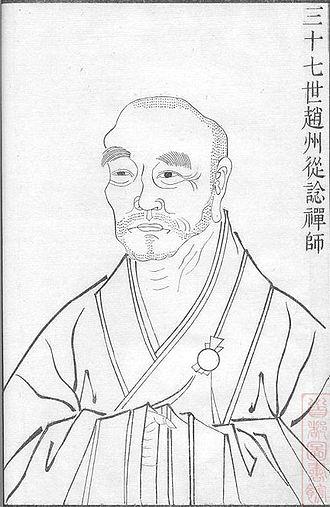
Buddhism during the three centuries, from the time of Seosan down to the next Japanese incursion into Korea in the late nineteenth century, remained fairly consistent with the above-described model. A number of eminent teachers appeared during the centuries after Seosan, but the Buddhism of the late Joseon, while keeping most of the common earlier characteristics, was especially marked by a revival of Hwaeom studies, and occasionally by new interpretations of methodology in Seon study. There was also a revival, during the final two centuries, of Pure Land Buddhism. Although the government maintained fairly tight control of the sangha, there was never again the extreme suppression of the early Joseon.
Buddhism during Japanese colonial rule
Under the Meiji Restoration in Japan during the 1870s, the government abolished celibacy in the Buddhist monkhood. Japanese Buddhists demanded the right to proselytize in the cities, lifting the five-hundred year ban on monks and nuns entering cities. The Japanese Jōdo Shinshū and Nichiren schools began sending missionaries to Korea. The formation of new Buddhist sects, such as Won Buddhism happened.
Soon after the Japanese annexation of Korea, Korean Buddhism took many changes. The Temple Ordinance of 1911 (寺刹令) virtually changed the traditional Korean system, whereby temples were run as a collective enterprise by the Sangha, replacing this system with Japanese-style management practices, in which temple abbots appointed by the Japanese Governor-General were given private ownership of temple property and given the rights of inheritance to such property. More importantly, monks from pro-Japanese factions began to adopt Japanese practices, by marrying and having children.
In 1920, the Temple Ordinance was revised to reorganize temple administration and allow the Japanese government to directly oversee the 31 main temples in the country, with new headquarters at Kakwangsa (now Jogyesa). Following the Japanese invasion of China in 1937, Korean Buddhism was placed under greater control. Japanese authorities had many temples’ artworks shipped to Japan. Negotiations for the repatriation of Korean Buddhist artworks are still ongoing.
Buddhism and Westernization (1945~present)
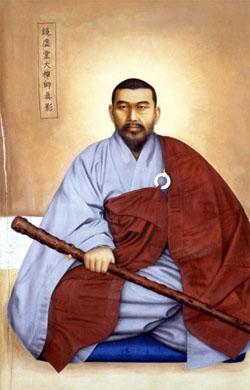
When Korea was liberated from Japanese occupation in 1945, the celibate monastics of what has become the largest sect of Korean Buddhism in terms of adherents and the number of clergy, Jogye Order, began to take over for the married priests who ran the temples during the occupation. This order sees itself as the primary representative of traditional Korean Buddhism in existence. The Taego order is the second largest order of Korean Buddhism and includes both celibate and married monks (nuns are expected to remain celibate). This is the only order that maintains the full Korean Buddhist ritual tradition.
South Korea
Starting in the 1950s, Syngman Rhee and others worked to further divide and weaken the Buddhist Sangha in the country. Rhee campaigned in 1954 against the so-called “Japanized Buddhists“. Western education and scholarship, and the empowerment of women and the poor, caused divisions among Koreans. Specifically, a deep rift opened between married priests and celibate monks, a carryover from Japanese Buddhism’s influence during the occupation period, though there had been calls for an end to celibacy from some Korean monks before Japan’s annexation of the Korean peninsula. The differences were so great that fistfights over the control of temples became frequent. Monks, mostly belonging to the celibate Jogye order, threatened to kill themselves. Many of them were against the married clergy. As the Buddhist riots continued, the influence of Buddhism lessened. Buddhism continued to lose followers to Christian missionaries, who were able to capitalize on these weaknesses.
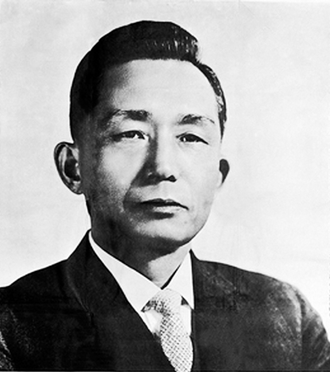
From the 1960s onward, Buddhism has grown considerably, through the formation of independent lay associations (that is, not funded or affiliated to the main orders), with many focused on youths, particularly to propagate and evangelize Buddhist teachings, fellowship and spiritual development, based on the Protestant model. These adaptations have modernized Buddhism in South Korea. Moreover, the South Korean government began devoting substantial funds to restore and reconstruct historic Buddhist temples, helping to revive Buddhism in the country. President Park Chung-hee unsuccessfully attempted during his rule (1961–1979) to settle the dispute by building a pan-national Buddhist organization. However, he did succeed in allying himself with the celibate faction, the Jogye Order.
It was in 1970 that Korean Buddhism split into a fully celibate order which retained the name “Jogye” and the Taego order that includes both celibate and married clergy. The Taego order retained the traditional red kasa whereas the Jogye order changed their kasa to brown to visually differentiate the two orders. Both orders continue to use the Dharmaguptaka Pratimoksha, the lineage of vows for monks and nuns taken in China and Vietnam, though Taego monks have the option of returning the vow of celibacy. When the Jogye order was founded, the government only recognized a small group of celibate Seon practitioners as “legitimate,” thus all of the ritual specialists remained with the Taego order.
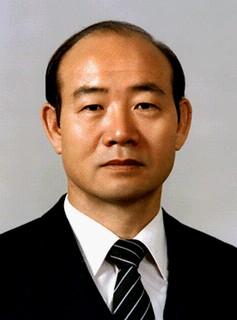
In the 1980s, President Chun Doo-hwan, a Methodist, adopted anti-Buddhist policies and attempted to restrict Buddhist activities. During his administration, many historic temples were converted into tourist resorts, which deprived temples of their autonomy, as these “national parks” were government-run. Consequently, Buddhists, especially the Jogye Order, were highly critical of these measures. From 27 to 31 October 1980, during the Kyeongsin Persecution, the government raided major Buddhist temples throughout the country, including the headquarters at Seoul’s Jogyesa, under the guise of anti-government investigations and an attempt to “purify” Buddhism. 55 monks were arrested and many others were interrogated and tortured, including the abbot of Naksansa, who died from the abuses. None of the investigated monks were ever charged, although many were sent to reeducation camps. Throughout the 1980s, the Buddhist community was kept under strict surveillance of government agents and many were prosecuted under false charges of supporting Communists or conspiracy.
To Buddhists, the construct of a state-protecting Buddhism (護國佛敎, Hoguk Bulgyo) had vanished, which served to radicalize a generation of Buddhists, including monks and laity and propelled them to start a movement called Minjung Buddhism (민중불교 or 民眾佛教, “practical Buddhism” or “Buddhism for the masses”). This modernization emphasized ordinary people and was a reaction to aggressive Christian proselytization in Korea. From the mid-1980s to date, Buddhism has expanded by through media and education. There are two major Buddhist media networks in South Korea, the Buddhist Broadcasting System (BBS), founded in 1990 and the Buddhist Cable TV Network, founded in 1995. Buddhist orders are also affiliated with or operate 3 universities, 26 schools and 16 seminaries in the country. The Kwan Um School of Zen is one of South Korea’s most successful international missionary institutions.
Lotus Lantern Festival
During the 1990s, conflicts between the South Korean government and Buddhist leaders, as well as with fundamentalist Protestant denominations, continued. The government accused Buddhism of immorality and many Protestants used this to forward their missionary work. Some religious gatherings have even turned violent, vandalizing statues of Buddha and Dangun, the mythical founder of Korea. Soon after the Buddhist Broadcasting Service’s FM radio station was launched in 1990, young men vandalized and destroyed sound facilities worth $200,000 USD. There was also a rash of temple burnings in the 1980s and 1990s, and attacks on Buddhist artwork have continued. In one instance, a Protestant minister used a microphone on a cord as a bolo weapon and smashed temple paintings and a statue. In other instances, red crosses have been painted on temple walls, murals, and statues. Buddha statues have also been decapitated. Furthermore, students at Buddhist universities report aggressive attempts to convert them on campus, especially near campus temples.

On and off, sectarian tensions between fundamentalist Protestants and Buddhists occasionally rise due to what has been seen as a tendency of government officials–many of whom are Christians, especially of Protestant denominations–to tilt the political balance in favour of Christians over Buddhists which has led to discontent within the Buddhist community. Of particular note was after Lee Myung-bak‘s ascendence to the Presidency when the high proportion of Christians in relation to Buddhists in the public sector became known–particularly the president’s cabinet, where there were 12 Christians to only one Buddhist. among other reported incidences.
Recently, the South Korean public has become increasingly critical of Protestant churches and leaders attacking Buddhist institutions and carrying out aggressive missionary tactics, with many Protestants leaving their churches and converting to either Buddhism or Catholicism. The growing discontent with Protestant Christianity in South Korea has contributed to a spiritual and cultural revival of Buddhism in South Korea, with the number of followers increasing in recent years. The new presidency of Park Geun-hye aims to help contribute to the suppression of Protestant attacks against Buddhists and Catholics in South Korea, with increasing calls for religious cooperation in the country under the administration. During the first year of the Park administration, a national message was delivered for the celebration of Buddha’s Birthday, a contrast from the former Lee Myung-bak presidency which tried to suppress Buddhist influence in South Korea.
North Korea
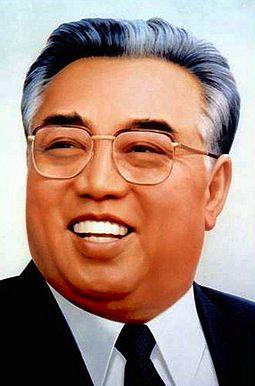
The regime in North Korea actively discourages the practice of religion, including Buddhism. Currently, the country claims to have about 10,000 active adherents of Buddhism. As with other religions in the country, Buddhism came under the close scrutiny of the country’s government–including worship at Buddhist temples by monks, through the state-sponsored Korea Buddhist Federation. A major temple is Pohyonsa which was preserved by Kim Il-Sung.
Nevertheless, Buddhists in North Korea reportedly fared better than other religious groups–particularly Christians, who were said to often face persecution by the authorities, and Buddhists were given limited funding by the government to promote the religion, given that Buddhism played an integral role in traditional Korean culture.
Current situation
The Seon school, which is dominated by the Jogye order in terms of the number of clergy and adherents, practices disciplined traditional Seon practice at a number of major mountain monasteries in Korea, often under the direction of highly regarded masters. The Taego order, though it has more temples than the Jogye Order, is second in size in terms of the number of clergy and adherents and, in addition to Seon meditation, keeps traditional Buddhist arts alive, such as ritual dance.https://www.youtube.com/embed/KlyKtF2QodQ?feature=oembed
Modern Seon practice is not far removed in content from the original practice of Jinul, who introduced the integrated combination of the practice of Gwanhwa meditation with the study of selected Buddhist texts. The Korean Sangha life is markedly itinerant for monks and nuns pursuing Seon meditation training: while each monk or nun has a “home” monastery, he or she will regularly travel throughout the mountains, staying as long as they wish, studying and teaching in the style of whatever monastery is housing them. The Korean monastic training system has seen a steadily increasing influx of Western practitioner-aspirants in the second half of the twentieth century. It must be noted, however, that the vast majority of Korean monks and nuns do not spend 20 or 30 years in the mountains pursuing Seon training in a form recognizable to westerners. Most Korean monks and nuns receive a traditional academic education, a modern academic education, and ritual training (though not necessarily in a formal ritual training program). Those who do spend time in meditation in the mountains may do so for a few years and then essentially return to the life of a parish priest.
Currently, Korean Buddhism is in a state of slow transition. While the reigning theory behind Korean Buddhism was based on Jinul’s “sudden enlightenment, gradual cultivation,” the modern Korean Seon master, Seongcheol’s revival of Hui Neng’s “sudden enlightenment, sudden cultivation” has taken Korean Buddhism by storm. Although there is resistance to change within the ranks of the Jogye order, with the last three Supreme Patriarchs’ stance that is in accordance with Seongcheol, there has been a gradual change in the atmosphere of Korean Buddhism.
Quite surprising to read that in a South East Asian country, an ancient and deep-rooted religion which has brought gems of art and knowledge to the country and its history, can be considered filthy by part of its own population. It's nothing new, it happened and happens also in Korea.
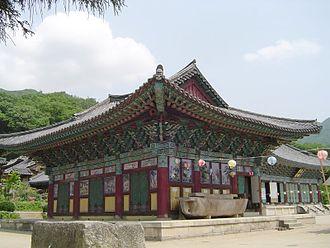
Antagonism from Korean Protestantism
Fundamentalist Protestant antagonism against Buddhism has increased in recent years. Acts of vandalism against Buddhist amenities and “regular praying for the destruction of all Buddhist temples” have all drawn attention to this persistent hostility against Buddhism from Korean Protestants. South Korean Buddhists have denounced what they view as discriminatory measures against them and their religion by the administration of President Lee Myung-bak, which they attribute to Lee being a Protestant. The Buddhist Jogye Order has accused the Lee government of discriminating against Buddhism by ignoring Buddhist temples in certain public documents. In 2006, according to the Asia Times, “Lee also sent a video prayer message to a Christian rally held in the southern city of Busan in which the worship leader prayed feverishly: ‘Lord, let the Buddhist temples in this country crumble down!'” Further, according to an article in Buddhist-Christian Studies: “Over the course of the last decade a fairly large number of Buddhist temples in South Korea have been destroyed or damaged by fire by misguided Protestant fundamentalists. More recently, Buddhist statues have been identified as idols, attacked and decapitated. Arrests are hard to effect, as the arsonists and vandals work by stealth of night.” A 2008 incident in which police investigated protesters who had been given sanctuary in the Jogye temple in Seoul and searched a car driven by Jigwan, then the executive chief of the Jogye order, led to protests by some claiming police had treated Jigwan as a criminal.
In October 2010, students from Church Equipping Worship School posted a clip on YouTube professing a hope that God would destroy a Buddhist temple in Seoul. Later they claimed being taught such by God.https://www.youtube.com/embed/DaU71lM3BXs?feature=oembed
Here another source about the conflict between Protestants and Buddhists.
Contemporary Seon
Since the middle of the 20th century Christianity has competed with Buddhism in South Korea, while religious practice has been suppressed in North Korea. Seon continues to be practiced in Korea today at a number of major monastic centers, as well as being taught at Dongguk University, which has a major of studies in this religion. The largest Buddhist denomination is the Jogye Order.
In the 1980s a debate arose about “sudden” versus “gradual” enlightenment”. Since Jinul Korean Seon was based on the integration of practice and scholarly study in the slogan “sudden enlightenment, gradual cultivation”. The modern Korean Seon master Seongcheol revived the slogan “sudden enlightenment, sudden cultivation”, ascribed to Hui Neng. The last three Supreme Patriarchs of the Jogye have a stance in this debate that is in accordance with Seongcheol.
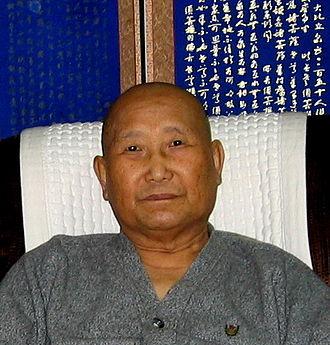
Spread in the USA
Korean Seon has been spread in the USA by Seung Sahn. He was a temple abbot in Seoul and after living in Hong Kong and Japan, he moved to the US in 1972, not speaking any English. On the flight to Los Angeles, a Korean American passenger offered him a job at a laundry in Providence, Rhode Island, which became headquarters of Seung Sahn’s Kwan Um School of Zen. Shortly after arriving in Providence, he attracted students and founded the Providence Zen Center. The Kwan Um School has more than 100 Zen centers on six continents.
Seung Sahn Soen Sa Nim's and Zen Master Wu Bong's lineage chart. More later.
Kyong Ho
Another Korean Zen teacher, Samu Sunim, founded Toronto’s Zen Buddhist Temple in 1971. He is head of the Buddhist Society for Compassionate Wisdom, which has temples in Ann Arbor, Chicago, Mexico City, and New York City. In the early 20th century, Master Kyong Ho (1849–1912), re-energized Korean Seon. At the end of World War II, his disciple, Master Mann Gong (1871–1946), proclaimed that lineage Dharma should be transmitted worldwide to encourage peace through enlightenment. Consequently, his Dharma successor, Hye Am (1884–1985) brought lineage Dharma to the United States. Hye Am’s Dharma successor, Myo Vong founded the Western Son Academy (1976), and his Korean disciple, Pohwa Sunim, founded World Zen Fellowship (1994) which includes various Zen centers in the United States, such as the Potomac Zen Sangha, the Patriarchal Zen Society and the Baltimore Zen Center.
Characteristics of Seon
Seon is known for its stress on meditation, monasticism, and asceticism. Many Korean monks have few personal possessions and sometimes cut off all relations with the outside world. Several are near mendicants traveling from temple to temple practicing meditation. The hermit-recluse life is prevalent among monks to whom meditation practice is considered of paramount importance.
Two defining characteristics of Korean Seon are its merging of practice and teaching, and its use of Hua Tou practice. Korean Seon uses Hua Tou practice as the main koan-practice, instead of the extended koan-curricula which are being used in Japan.
Another defining characteristic of Korean Seon in comparison with other similar schools in Asia is its emphasis on a process described as “sudden awakening/gradual cultivation” in contrast to “sudden awakening/sudden cultivation” that is typical of the Linji and Rinzai schools in China and Japan respectively. In the “sudden awakening/gradual cultivation” approach, one initially awakens to the concept that one is already a perfect Buddha, but their Buddhahood is obscured by ignorance and other mental defilements. However, in order to make Buddhahood a reality, the Seon practitioner must continue to cultivate wholesome states of mind and remove defilements through Seon practices until Buddhahood is fully realized. This approach was previously expounded by the Chinese Ho-tse School of Chan master Zongmi, but was further developed in Korea whereas it died out in China.
LINKS
Buddhist Korean Orders:
The Jogye Order of Korean Buddhism and it’s library.
Great Seon Master jinje, Supreme Patriarch of the Jogye Order of Korean Buddhism.
The Taego Order of Korean Buddhism
Temples:
Seon Center in Seoul
Most important Korean Temple to visit
Korean Buddhist writings:
The Collected Works of Korean Buddhism, a huge project.
Collected Works of Korean Buddhism from UCLA
A collection of Korean Buddhist Writings from Buddhist elibrary
The Korean Society for Buddhist Studies
The Korean Association of Buddhist Studies 한국불교학회
Wikipedia:
http://en.wikipedia.org/wiki/Korean_Buddhism
http://en.wikipedia.org/wiki/Korean_Seon
